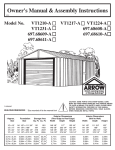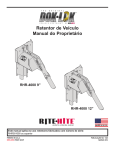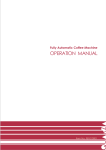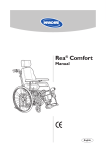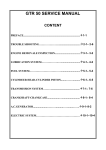Download Honda HRA21 User's Manual
Transcript
The HRA-21 meets CPSC blade safety requirement for walkbehind rotary power mowers. MOWER HRA2 1. This manual covers operation and maintenance of the HONDA ROTARY All information in this publication is based on the latest product information available at the time of approval for printing. Honda Motor Co., Ltd. reserves the right to make changes at any time without notice and without incurring any obligation. Any powered product can be a potential source of danger if misused or improperly maintained. Pay particular attention to statements preceded by the following words: Indicates the possibility of personal injury or loss of life if instructions are not followed. Indicates the possibility of equipment damage if instructions are not followed. HONDA MOTOR CO., LTD 1982, ALL RIGHTS RESERVED Thank you for purchasing a Honda Lawn Mower. If any problems occur, or if there are any questions concerning the mower, consult an authorized HONDA dealer. No part of this publication may be reproduced without written permission. The Honda rotary mower is designed to give safe and dependable service if operated according to instructions and intended use: mowing (cutting) grass, and bagging cut grass when equipped with the grass bag. Any other use could be dangerous. Read and understand the Owner% Manual before operating the mower. injury or equipment damage. 2 Failure to do so could result in personal CONTENTS.. ............................... GENERAL SAFETY COMPONENT IDENTIFICATION THECONTROLS.. OPERATION 3 ............................................................ ............................................. ........................................................ ............................................................. TRANSPORTING/STORAGE MAINTENANCE .......................................................... TROUBLESHOOTING SPECIFICATIONS ................................................ ..................................................... ......................................................... : ....................... 4 5 7 9 18 21 33 34 3 GENERAL SAFETY * Know how to stop the engine quickly and understand operation of aN rhe controls. Never permit anyone to operate the mower without proper instrut tion. * The rear shield is for your protection; keep it in place at all times. * The blade is sharp and dangerous. Never put your hands or feet under the mower. Never tilt the mower to expose the blade while the engine is runFing. If you find it necessary to work on the blade or mower, stop the engine and remove the spark plug cap. * Never stand in front of self-propelled mowers when the engine is running. Someone may accidentally engage the drive clutch. * Keep clear of the discharge opening when the bag is not attached to avoid being hit by a flying objet t. Clear the lawn of sticks, stones, or debris before mowing. Mow only in cleared areas in daylight or good artificial light. * Protect yourself by wearing long .trousers and appropriate shoes. Don’t wear loose fitting clothing or sandals when mowing. * Keep children and pets away from the mower at all times. * If the blade strikes a stone, sprinkler head, etc., be sure the blade, blade holder, woodruffkey, fasteners, crankshaft, etc. are in good condition before continuing to mow. Replace any damaged parts. COMPONENT IDENTIFICATION GRASS BAG HANDLE ROTO-STOP LEVER THROTTLE LEVER FUEL TANK CAP RECOIL STARTER 1 AIR CLEANER SPARK PLUG CAP CUTTING HEIGHT ADJUSTING LEYER GRASS BAG MUFFLER ENGINE OIL DRAIN PLUG SDA Type 5 DRIVE CLUTCH LEVER 1 ~HANDLE GRASS BAG GRIP ,,lSC..,ARGE G,, REAR SHIELD 6 OIL FILLER CAP THE CONTROLS THROTTLE CONTROL Throttle (All TYPES) “CHOKE” “HI” “LO” “IDLE” “STOP” ROTO-STOP (All TYPES) To put the cutting blade into operation, press the button on top of the ROTO-STOP lever and push the lever forward, holding it against the handlebar. The blade will stop when the ROTO-STOP lever is released. ROTO-STOP LEVER LEVER I)rive Clutch (SDA and SDAW ,TYPES) For self-propelled operation, push the drive clutch lever forward and hold it against the handlebar. The drive clutch lever holds the ROTO-STOP lever forward during self-propelled operation. The button on top of the ROTO-STOP lever must be pressed before either of these levers can be moved forward the cutting blade must be put into operation whenever the mower is to be self-propelled. When the drive clutch lever is released, the drive clutch is disengaged and the ROTO-STOP lever is released. TRACTION SPEED The mower has three speed settings for the self-propelled operation and is delivered by the dealer in the intermediate speed setting. Changing to a faster or slower speed should be accomplished by an authorized Honda dealer. OPERATION The HRA21 may be used with the grass bag or discharge adapter. The following suggestions and rules are intended to help you operate your Honda HRA21 under the safest conditions possible. Be alert and exercise the same care using the mower as you would using any other power tool. * Be especially careful when mowing uneven or rough ground. The mower may tilt, exposing the blade, and hidden objects could be thrown by the blade. Keep all four wheels on the ground. 1 I * Use extra care when mowing around objects to keep the blade from striking them. Never deliberately mow over any object. * Stop the engine immediately if the blade hits an object or the mower starts to vibrate. Remove the spark plug cap (keep the wire away from the plug) and inspect for damage. NOTE: Mow across slopes. Do not mow excessively steep slopes. Always push, never pull, a mower with the engine running. Control direction by the handle, not by foot pressure on the mower housing. Keep a firm hold on the handle and walk, never run, with the mower. Don’t lag behind the machine or let it pull you. (SDA and SDAW TYPES) Do not use the drive clutch when maneuvering around trees, etc. Release the clutch and push the mower while using the ROTO-STOP for better directional control. BEFORE YOU START THE MObVER 1. Check the engine oil level. pY5V-l * Engine oil is a .major factor affecting engine per- formance and service life. Non-detergent or vegetable oils are not recommended. * Running the engine with insufficient oil can cause serious engine damage. Use Honda-&troke, or an equivalent high detergent, premium quality motor oil certified to meet or exceed U.S. automobile manufacturers’ requirements for service classification SE or SF. (Motor oils classified SE or SF will show this designation on the container.) SAE low-40 is recommended for general, all temperature use. If single viscosity oil is used, select the appropriate viscosity for the average temperature in your area. A. With the mower on a level ‘surface, remove the oil filler cap/dipstick using a screwdriver as illustrated. B. If the level is low, add the recommended oil to the “Upper” mark on the dipstick. Do not overfill; excess oil will result in power loss and smoking. 10 UPPER OIL LEVEL LOWER OIL LEVEL 2. Check the fuel level. Use regular or unleaded automotive gasoline of 86 pump octane or higher. Never use an oil/gasoline mixture or dirty gasoline. Avoid getting dirt, dust or water in the fuel tank. * Gasoline is extremely flammable and explosive under certain conditions. Refuel in a well ventilated area with the engine stopped. * Do not smoke or allow flames or sparks in the area where the mower is refueled or where gasoline is stored. * Be careful not to spill fuel when refueling. Fuel vapor or spilled fuel may ignite. Make sure the area is dry before starting the engine. * Do not overfill the tank and make sure the filler cap is securely closed after refueling. * Refuel when the engine is cold. -1 Gasoline substitutes, such as gasohol etc., are not recommended, they may be harmful to the fuel system covponents. 11 3. Check the grass bag for fraying, tears and clogged mesh. Wash the bag with water if necessary, and let it dry thoroughly. Grass will not chute properly without adequate ventilation through the bag. Make sure the lock lever is latched securely. 4. Check the blade bolts for tightness. Torque: 455.5 kg m ( 32.5-39.8 ft lb) * To be certain that the engine will not start accidentally, remove the spark plug cap before performing this inspection. 5. Check and clean the air cleaner element if it is dirty (p. 24). 12 STARTING THE ENGINE * Exhaust gas contains poisonous carbon monoxide. Never run the mower in an enclosed area. Be sure to provide adequate ventilation. 1. Move the throttle lever to “CHOKE”. NOTE: Do not use “CHOKE” when the engine is warm or the air temperature is high. Move the throttle to “LO” instead. CHOKE HROTTLE 2. Turn the fuel valve “ON”. LEVER 3. Place your foot on the “STEP” of the mower housing. 4. Pull the starter rope lightly until you feel compression, then pull briskly. NOTE: Do not allow the rope to snap back; return it by hand. 5. After the engine warms up, move the throttle lever to “HI”. Squeeze the ROTO-STOP to start the blade. SDA and SDAW TYPES: Engage the drive clutch/ ROTO-STOP. Mower will move forward. NOTE: The throttle lever may be moved anywhere between “HI” and “LO” to adjust engine speed during operation. However the engine may stall if the lever is at “IDLE” when the ROTO-STOP is engaged. * ’ Flooded Engine If the engine won’t start after several pulls on the starter rope the engine is probably flooded. To clear a flooded engine: 1. Move the throttle lever to “STOP” and turn off the fuel valve. 2. Remove and dry the spark plug. When re-installing the plug, thread it in by hand until it seats. Then tighten it an additional l/8- l/4 turn with the spark plug wrench to compress the washer. 3. Move the throttle to “HI”, turn on the fuel valve and repeat steps 3-5 under “Starting the Engine”. Stopping the Engine 1. Release the roto-stop lever. SDA and SDAW TYPES: Release the drive clutch lever. 2. Move the throttle lever to “STOP” and turn off the fuel valve. ROTTLE LEVER Cutting Height Adjustment Six settings are available: S/8”, l”, l-1/2”,2”,2-1/2”,3”. To change blade height: 1. Stop the engine. 2. Push the adjusting lever t&ward the wheel and move it up or down to raise or lower the blade height. 3. Release the lever in the appropriate notch. 4. Adjust the other three wheels. Make sure all four wheels are at the same level. * Be careful not to touch the muffler when adjusting the right front wheel height. The muffler wiN stay hot for a while after the engine is stopped. [CAUTION: * Adiust all four wheels to the same level. 3” 16 lJ-===-F -w ADJUSTING LEVER Grass Bag The bag is subject to wear under normal usage; frequently check for fraying and tears. Replace deteriorated bags only with Honda replacement bags or equivalent. When the bag needs cleaning, wash it with water and make sure it is dry before using it. Clogged mesh will result in poor grass chuting and a wet bag will clog quickly. Removale q Remove the grass bag grip from handle pipe. a Push the door latch down. q Pull the grass bag rear ward while pushing the door latch down. Installation ‘$J Grab the grass bag handle, set the lower edge of the bag onto the recess of the mower housing. q Push the grass bag handle forward until the forward end of the handle rests on the latch groove. q Hang the grass bag grip onto the lower handlebar. TRANSPORTING/STORAGE Transporting Turn the fuel valve OFF when transporting Preparation for Storage The following steps should be taken to protect the mower whenever it will be stored for longer than 30 the days. mower. 1. Drain the fuel tank and carburetor into an approved gasoline container: A. Remove the fuel tube and turn the fuel valve ON to empty the fuel tank. * To avoid fuel and oil spillage do not tilt the unit; spilled fuel may ignite. 18 Loosen the carburetor drain bolt to drain the carburetor. C. Retighten the drain bolt, connect the fuel tube and turn the fuel valve OFF. B. * Gasoline is extremely flammable and explosive under certain conditions. Do not smoke or allow flames or sparks in the area. 2. Change the engine oil (p. 23). NOTE : If the mower will be stored for longer than a year, remove the spark plug and pour three tablespoonsful of clean motor oil into the cylinder. Pull the starter rope slowly two or three times to distribute the oil. Replace the plug. I DRAIN BOLT 1 I 19 3. Pull the starter rope until resistance is felt. This closes the valves and helps to protect the combustion chamber from corrosion. 4. Remove dirt and debris from the underside of the mower housing. Clean the mower thoroughly. Paint areas that may rust with a rust-resistant paint, or coat with a light film of oil. 5. Cover the mower and store it on a level surface in a dry, dust-free area. Removal From Storage 1. Remove the spark plug; check that it is clean and properly gapped (p. 25). Pull the starter rope several times. 2. Thread the spark plug in as far as possible by hand, then use the plug wrench to tighten l/8 to l/4 turn further. 3. Check the engine oil level and condition. 4. Fill the fuel tank and start the engine., NOTE: If the cylinder was coated with oil, the engine will smoke at start up; this is normal. 20 STARTER HANDLE MAINTENANCE * To prevent accidental start-up, shut off the engine and disconnect the spark plug cap before performing any maintenance. * Use only genuine Honda parts or their equivalent Replacement parts for maintenance or repair. which are not of equivalent quality may damage the mower. Periodic inspection and adjustment of the Honda HRA2 1 are essential it high level performance is to be maintained. Regular maintenance will also help to extend service life. The required service intervals and the kind of maintenance to be performed are described in the chart on the following page. For longer service and greater efficiency, keep the underside of the mower housing clean and free of accumulated grass clippings by washing it down with a hose after use and/or cleaning it with a wire brush and scraper. Remove any rust and apply a rust-resistant paint. Cleaning and rust prevention are especially important before seasonal storage. 21 MAINTENANCESCHEDULE Regular Service Period Perform at every indicated month or operating hour intervals, whichever occurs first. , Each Use First 1 month Every 1 month Every 6 months 20’irs. 20°4rs. 1OCGIrs. Every one year 3OCkS. 3ngine oil 4ir cleaner element Gel strainer spark plug 31ade bolts (Tightness) brass bag Throttle cable Drive belt Drive clutch cable XOTO-STOP cable tOTO-STOP __gnition timing Valve clearance Combustion chamber ?uel tank ‘uel tube l *+ 22 Check level Change Check Check Check Clean-Adjust Check Check Adjust Inspection Adjust Adjust Check Check-Adjust -__ Check-Adjust C$fe;- Lap -Clean Check (Replace, if necessary) 0 0 0 0 0+ 0 0 0 I 0 I , I I , 0 0 0 0 0** 0 ** 0 ** 0 +* I y 0 Service the air cleaner more frequently when used in dusty areas. These items should be serviced by an authorized Honda dealer, unless the owner has the proper tools and is mechanically See the Honda Shop Manual.. J proficient. ENGINE OIL CHANGE Drain the oil while the engine is still warm to assure rapid and complete draining. 1. Remove the tiller cap/dipstick using a screwdriver as illustrated. 2. Remove the dram bolt, drain the oil, and retighten the bolt securely. 3. Refill to the “Upper” level mark with the recommeded oil (see p. 10). Tighten-the cap securely to prevent leakage. \ I II- OIL DdAlN LOWER BOLT AIR CLEANER SERVICE A dirty air cleaner will restrict air flow to the carburetor. To prevent carburetor malfunction, service the air cleaner frequently. l.Remove the wing nuts and the air cleaner cover. Remove the elements and separate them. Carefully check both elements for holes or tears and replace if damaged. 2.Foam element: Clean in warm soapy water, rinse and allow to dry thoroughly. Or clean in high flash-point solvent and allow to dry. Dip the element in clean engine oil and squeeze out all the excess. The engine will smoke during initial startup if too much oil is left in the foam. 3. Paper element: Tap the element lightly several times on a hard surface to remove excess dirt, or blow compressed air through the filter from the inside out. Never try to brush the dirt off; brushing will force dirt into the fibers, Clean in warm, soapy water and rinse. Dry using compressed air blown from the inside out, or shake the element and allow it to air dry thoroughly. (Or clean in high flashpoint solvent, remove immediately, and allow to dry.) Oil the outside of the paper with a light aerosol oil such as WD-40. The engine will smoke during initial start-up if too much oil is used. 24 I I PAPER ELEMENT I WING NUTS .--- :...: F FOAM ELEMENT SPARKPLUG Standard Plugs: BMR-6A (NGK) or W20MR-U (ND) 1. Disconnect the cap and remove the spark plug. 2. Visually inspect the plug. Discard the plug if it is heavily deposited or if the insulator is cracked or chipped. 3. Measure the plug gap with a wire-type feeler gauge; it should be 0.6-0.7 mm (0.024-0.028 in). If adjustment is necessary, bend the side electrode carefully. 4. Make sure the sealing washer is in good condition, then thread the spark plug in by hand until it seats. 5. Use the wrench to tighten a new plug l/2 turn further to compress the washer. If you are reusing the plug it should only take l/8 - l/4 turn after the plug seats. 6. Replace the spark plug cap. I 1 0.6-0.7 mm (0.024-0.028 in) 25 BLADE REMOVAL AND SHARPENING * Wear heavy gloves COprotect your hands. Before tilting the mower, remove the spark plug cap. 1. Tilt the mower so the carburetor side is up. Loosen the blade bolts to remove the blade. * Never tilt the mower so the carburetor side is down. It will result in hard starting. 2. Sharpen the blade cutting edges with a file. File the top side only. Maintain the original bevel for a fine cutting edge. File both ends evenly to maintain blade balance. NOTE: Use only a genuine HONDA replacement blade or equivalent. 3. Clean away any dirt and grass from around the blade shaft. 4. Install the blade so that the blade bolts are securely tightened with specified torque. Torque: 4.5 - 5.5 kg m (32.5 - 39.8 ft lb) 26 IJP THROTTLE CONTROL CABLE ADJUSTMENT 1. With the throttle lever in the “CHOKE” position, the carburetor control lever should be pulled all the way to the right. Push the control lever with your finger to check whether it is all the way to the right. 2. If adjustment is necessary, loosen the lock nuts and turn them to run the adjuster up or down as required. Tighten the lock nuts and recheck the carburetor control lever position. 3. Start the engine and make sure the engine stops when the throttle lever is moved to the “STOP” position. Readjust the cable if necessary. CHOKE OTTLE I- NUTS ADJUSTER LEVER ROTO-STOP LEVER FREE PLAY (All TYPES) I 5-10mm (3/15-3/8 in) I 1. Measure free play at the tip of the lever as shown; it should be between 5 - 10 mm (3/ 16 - 3/8 in). 2. If adjustment is necessary, loosen the lock nuts and turn them to run the adjuster up or down as required. Tighten the lock nuts and reckeck free play. 3. Start the engine and operate the ROTO-STOP lever. Check to be sure the blade stops when the lever is released. 28 -STOP LEVER DRIVE CLUTCH FREE PLAY (SDA and SDAW TYPES) 7-12 1. Measure free play at the top of the lever as shown; it should be between 7- 12 mm (9132-l 5132 in>. 2. If adjustment is necessary, loosen the lock nuts and turn them to run the adjuster up or down as required. Tighten the lock nuts and recheck free play. 3. Start the engine and check to be sure the drive clutch engages and releases properly. L mm (g/32-15/32 in) NOTE: The following adjustments should be performed by an authorized Honda dealer unless the owner has the proper tools and is mechanically proficient. 1. Move the throttle lever to “IDLE” and start the engine. 2. Turn the throttle stop screw either in or out as required until the engine runs at 1,400 rpm. THROTTLE 30 STOP SCREW RASS BAG ASSEMBLY 2. Place the anti-sag rod in the bag as shown and secure its upper sides to the upper frame with two nuts. , 3. Turn the bag upside down. Install the lower frame with the lipped edge forward and secure it with two screws as shown. 4. Insert the lower plate into the bag and secure it to the lower frame with three bolts and washers. GRA 5. Install the grass bag handle onto the upper frame with two cap nuts as shown. 32 6. Install the grass bag grip by putting its ends in the pivot hole on the rear end of the anti-sag rod. TROUBLESHOOTING CHART Engine will not start I. No fuel. 2. Throttle lever in “STOP” position. 3. Spark plug wire loose or disconnected. 4. Spark plug faulty or improperly gapped (p. 25). 5. Engine flooded (p. 15). 6. Dirty air cleaner. Hard starting or loss of power 1. Dirt in gas tank. 2. Dirty air cleaner. 3. Water in gas tank. 4. Vent in gas cap and/or carburetor clogged. Erratic operation I. Spark plug faulty or improperly gapped (p.25). 2. Dirty air cleaner. Engine overheats 1. Spark plug improperly gapped. 2. Dirty air cleaner. 3. Dirty cooling fins. 4. Low oil level. 5. Starter pulley clogged by grass, etc. Excessive vibration 1. Loose blade or engine mounting hardware. 2. Blade unbalanced. 33 SPECIFICATIONS MODEL .................................. ENGINE .................................. Engine type ............................. Displacement/Bore and stroke ............... Ignition timing ........................... Ignition system ........................... Engine oil capacity ........................ Fuel tank capacity ........................ Spark plug .............................. ROTARY MOWER HRA2 1 GVl50 Side valve, single-cylinder, forced air-cooled four-stroke gasoline engine. 144 cc (8.8 cu in)/64 x 45 mm (2.52 x 1:77 in) 20” BTDC, Fixed Flywheel magneto ignition 0.6 l(0.63 US qt) 1.0 1 (0.26 US gal) BMRdA(NGK), WQOMR-U(ND) FRAME Dimensions (Length x Width x Height) . . . . . . . . 1,585 x 540 x 975mm (62.4 x 21.3 x 38.4in) Dry weight . . . . . . . . . . . . . . . . . . . . . . . . . . . . . . SDATYPE: 44.5 kg(98 lb) SDAW TYPE: 43.5 kg (96 lb) PDA TYPE: 41.5 kg(91 lb) PDAW TYPE: 40.5 kg (89 lb) Grass bag capacity . . . . . . . . . . . . . . . . . . . . . . . . 80Q (2.2 bu) Cutting width . . . . . . . . . . . . . . . . . . . . . . . . . . . . 540 mm (21 in) 34











































